Freshwater fish dominate production

Brazil has exceptional conditions for the production of freshwater organisms. Its 8.5 million-square-kilometer land area includes one of the largest hydrographic basins in the world. With almost 12 percent of the planet’s available freshwater, Brazil has about 2 million ha of dams and water reservoirs. In addition, vast portions of the country have warm temperatures year-round and a large diversity of native freshwater species. Brazil also has a large consumer market and the scientific knowledge to support the suitable use of aquatic ecosystems.
General production

Brazilian fisheries production is somewhat difficult to estimate because the data-collecting system is inefficient and available statistics are inadequate. Information on marine production in Brazil is suitable, but figures on freshwater production tend to be underestimated.
Recent assessments indicated that Brazil’s annual seafood production was almost 1 million metric tons. Marine fisheries contributed 50 percent to the total, inland fisheries 24 percent, marine aquaculture 8 percent, and inland aquaculture 18 percent. After a period of large increase during the past decades, inland production has remained stable at around 180,000 metric tons (MT) per year since 2002.
Despite its colder climate, southern Brazil produces 59,000 MT of freshwater aquaculture products annually, a third of the inland aquaculture total. This area is followed in product volume by northeastern Brazil (35,000 MT), midwestern Brazil (33,000 MT), southeastern Brazil (33,000 MT), and northern Brazil, with 20,000 MT.
Valued at about U.S. $220 million/year, freshwater fish culture dominates inland production. It is worthy to note that the value of Brazilian fisheries products has been overestimated by the United Nations Food and Agriculture Organization, which presented a mean worth of about $4.00/kg, while the real value is about $1.20/kg.
Culture species
Over 60 species of fish, crustaceans, amphibians, and reptiles have been cultured in inland areas. However, finfish contribute over 99 percent of production, while the annual production of freshwater prawns (Macrobrachium rosenbergii) and frogs (Rana catesbeiana) is less than 1,000 MT. In addition, there are culture operations for turtles, pilot-scale alligator farming in the northern and midwestern regions of Brazil, and some commercial culture of marine shrimp (Litopenaeus vannamei) in oligohaline continental waters in the northeast.
Freshwater fish aquaculture is practiced in every state, followed by freshwater prawns, which are cultivated in 20 states. Frogs are mainly produced in the southeastern region. Intensive studies of the Amazon River prawn, (Macrobrachium amazonicum), have indicated significant culture potential in inland waters. Several ornamental species also have culture potential.
Brazilian inland aquaculture is based on small-scale production units. Over 85 percent of farms are smaller than 2 ha, while less than 0.01 percent are greater than 50 ha. Generally, farmers buy seedstock from private hatcheries, which may be very large and sophisticated or simple, small backyard setups. Grow-out of fish, marine shrimp, or freshwater prawns is typically carried out in earthen ponds, but tilapia culture in reservoir cages is increasing. Very few fish farms use raceways.
Freshwater fish farming
The 100,000 freshwater fish farmers in Brazil currently produce about 179,000 MT/year. Most production is for local human consumption, with fee fishing also an important market in Brazil’s southeast. Some producers have started to explore international markets.
Tilapia and carp dominate, contributing over 60 percent of the overall production (Fig. 1). Tilapia culture is based on Nile tilapia (Oreochromis niloticus) sexually reverted to male during the fingerling phase. Currently, tilapia culture is expanding from earthen ponds to cages in public waters.
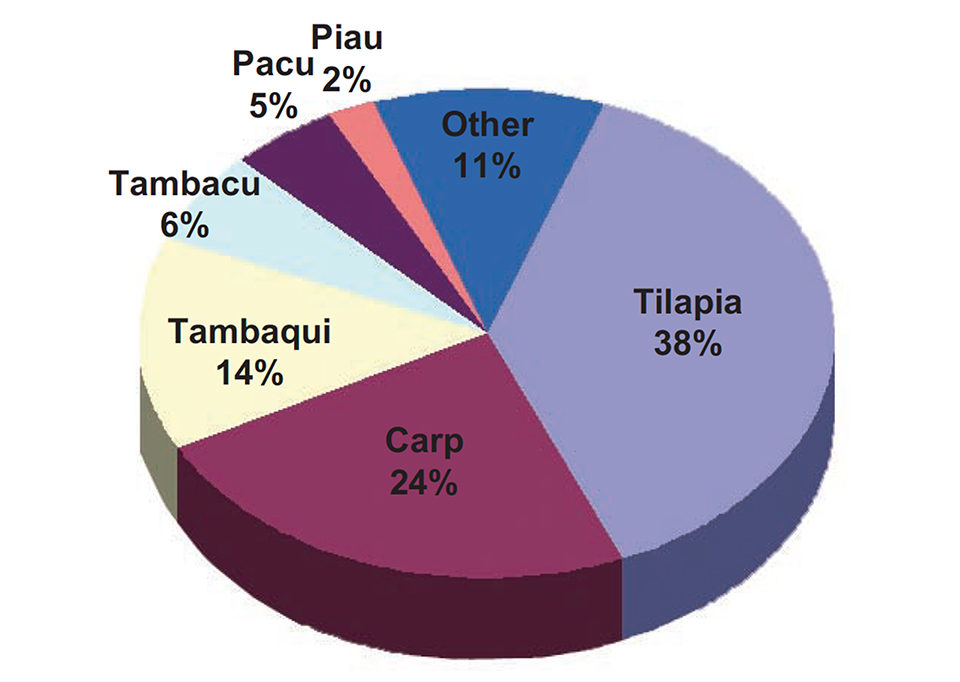
Common, grass, silver, and bighead carp are the main carp species commonly farmed in polyculture integrated with swine production. Tilapia are sometimes added to this polyculture. This approach, certainly the most sustainable system of aquaculture used in Brazil, has been profitable for over 20 years. However, technology for this polyculture has been improved, with increases in productivity and profit.
Rainbow trout and North American catfish are other nonindigenous species produced in the southern and southeastern regions. The farming of the native species tambaqui, pacu, and their hybrid tambacu is very important all over the country, followed by piau. Other native species – matrinxã, piracanjuba, curimatã, and pintado – have been farmed, while pirarucu and jundiá have promising perspectives.
Research and development
Brazil has 90 research institutions, including universities, involved in aquaculture across the country. In addition, aquaculture courses from undergraduate to doctorate level are available in various Brazilian states.
Brazil already has a scientific base to support aquaculture. However, the fact that current methods for extension are ineffective is probably the main constraint for industry development. National research priorities include the development of multi-institutional research programs that contemplate regional necessities and projects to promote works that integrate research institutions and aquafarms.
Perspectives
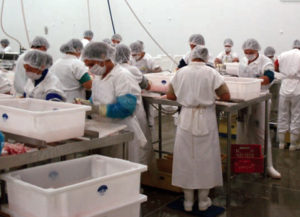
Brazilian aquaculture has grown significantly during the past years, but there are still several weak elements in the production chain, including extension services, loan policies, environmental legislation, processing, distribution, and commercialization.
During the past decade, a great effort was made to introduce responsible practices in Brazilian aquaculture to address the challenge of developing innovative environmentally, socially, and economically well-balanced systems that optimize production efficiency, distribute wealth, and sustain healthy costal and inland ecosystems. Polyculture, efficient use of wastes from processing, and combining aquaculture with other cultures or ecotourism projects may offer possible solutions.
(Editor’s Note: This article was originally published in the May/June 2007 print edition of the Global Aquaculture Advocate.)
Now that you've reached the end of the article ...
… please consider supporting GSA’s mission to advance responsible seafood practices through education, advocacy and third-party assurances. The Advocate aims to document the evolution of responsible seafood practices and share the expansive knowledge of our vast network of contributors.
By becoming a Global Seafood Alliance member, you’re ensuring that all of the pre-competitive work we do through member benefits, resources and events can continue. Individual membership costs just $50 a year.
Not a GSA member? Join us.
Author
-
Prof. Wagner C. Valenti
São Paulo State Univeristy Aquaculture Center
Departamento de Biologia Aplicada, FCAV, UNESP
14884-900 Jaboticabal, S.P., Brazil
Tagged With
Related Posts
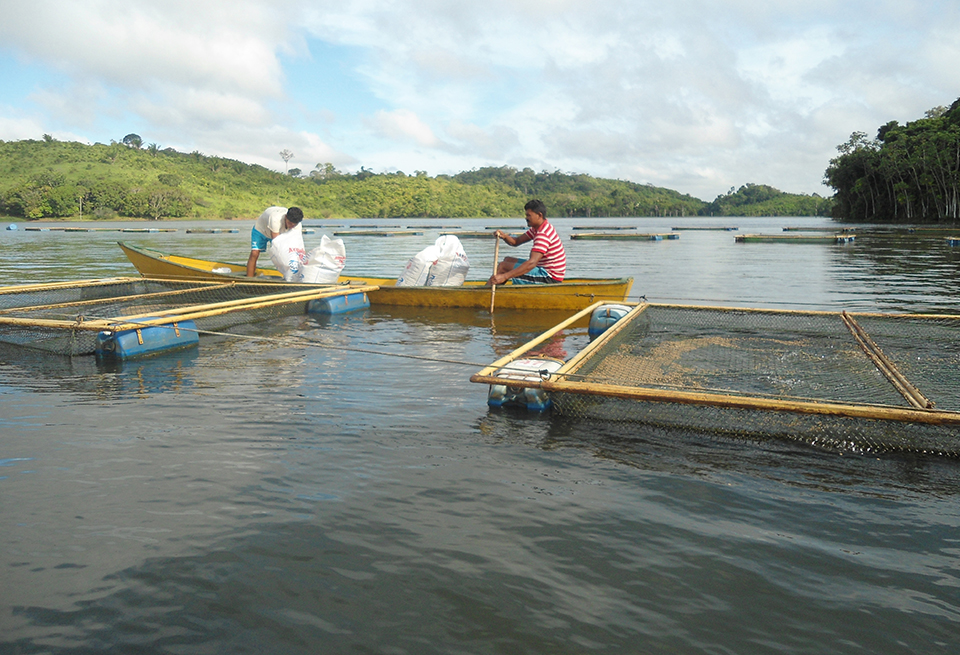
Innovation & Investment
Aquaculture planning, development in Brazilian federal waters
The aquaculture industry in Brazil is moving toward further expansion with the support of the federal government. A key strategy of the More Fishing and Aquaculture plan is the development of aquaculture in federal waters. The plan promotes sustainable development of fisheries and aquaculture by linking those involved and consolidating state policies addressing social inclusion, security and food sovereignty. Tilapia is the main farmed fish, although tambaqui and others have potential for large-scale production due to their wide acceptance by consumers.
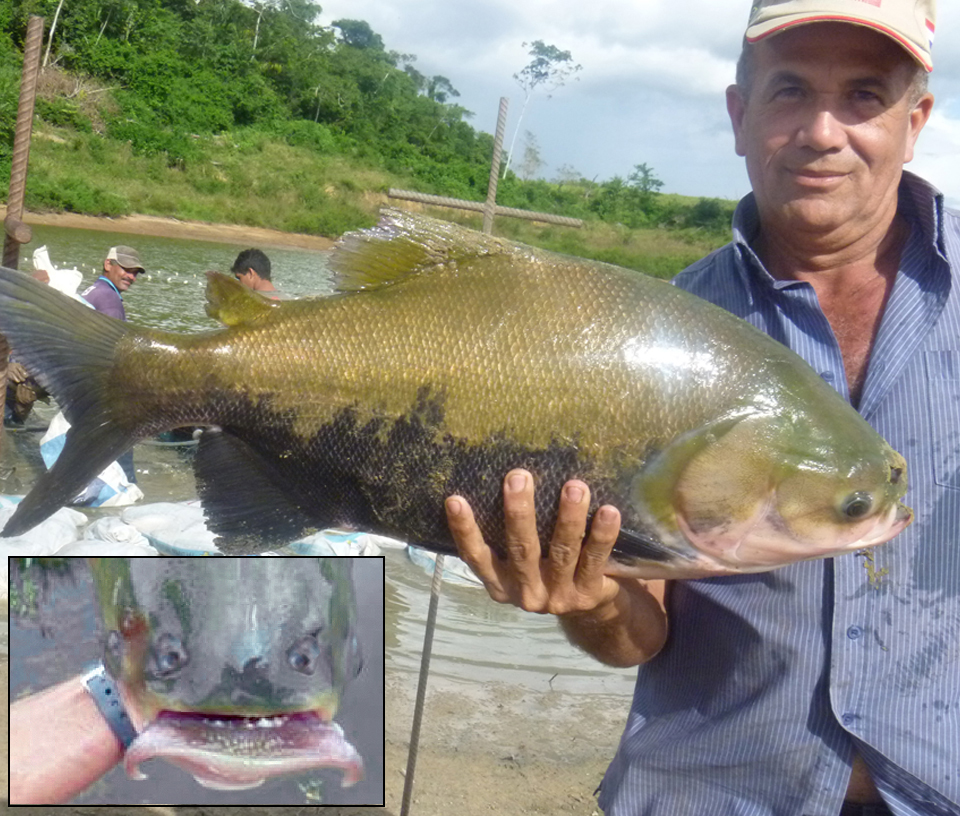
Health & Welfare
Aquaculture of Amazon fish in Latin America
Many fish species that live in the Amazon basin have great potential for aquaculture. The main species currently cultured in the region is tambaqui, a fast-growing, omnivorous fish that tolerates poor water quality.

Health & Welfare
Brazil shrimp farm performs genetic selection for IMNV resistance, growth
The Queiroz Galvão Alimentos shrimp farm and hatchery in Brazil have been working with Concepto Azul to implement a disease-prevention and genetic-breeding program that addresses ongoing impacts from infectious myonecrosis virus (IMNV) and other pathogens.
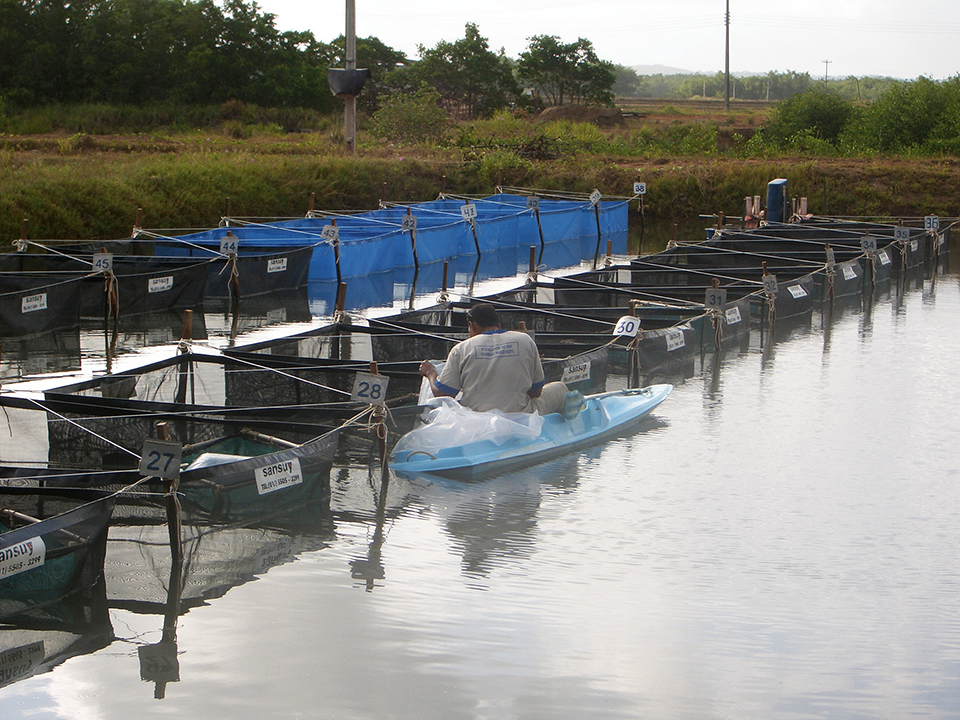
Health & Welfare
Field performance of imported SPF shrimp in Brazil
Combined analyses of SPF shrimp from six imported lines and one commercial genetically improved line in Brazil found excellent winter performance.



